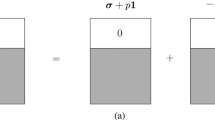Abstract
Measurement of complex electrical conductivity as a function of frequency is an extremely sensitive probe for changes in pore and crack volume, crack connectivity, and crack surface topography. Such measurements have been made as a function of pore fluid chemistry, hydrostatic confining pressure, as well as uniaxial and triaxial deformation. This paper will; (1) describe the effects of triaxial deformation on the complex electrical conductivity of saturated porous rocks, (2) use the electrical data to model the mechanical stress-strain behaviour, and (3) compare the modelled behaviour with the stress-strain behaviour measured during the deformation. Experimental conductivity data tracks how the rock undergoes compaction with progressive loss of crack volume, followed by dilatation due to new crack formation, growth of existing cracks, crack interlinkage, and finally failure, as axial strain is increased. We have used the complex electrical data to produce a direction-sensitive (anisotropic) crack damage parameter, and used it to calculate the effective Young's modulus by employing the models of Walsh and Bruner. Comparison of the synthetic stress-strain curves so produced, with the experimentally derived stress-strain curves shows good agreement, particularly for undrained tests. This modelling is an improvement on similar curves produced using isotropic crack damage parameters derived from acoustic emission data. The improvement is likely to be due to the directional sensitivity of the electrical conductivity measurement, and its ability to discriminate between the formation of isolated cracks, and those cracks that contribute to the inter-connected crack space i.e. those cracks upon which transport properties of the rock such as electrical conductivity, and mechanical properties depend most critically during triaxial deformation.
Similar content being viewed by others
References
Bruner, W. M.: 1976, ‘Comment on Seismic Velocities in Dry and Saturated Cracked Solids’,J. Geophys. Res. 81, 2573–2576.
Cox, S. J. D. and Meredith, P. G.: 1993, ‘Microcrack Formation and Material Softening in Rock Measured by Monitoring Acoustic Emissions’,Int. J. Rock Mech. Min. Sci. & Geomech. Abstr. 30, 11–24.
Glover, P. W. J., Meredith, P. G., Sammonds, P. R. and Murrell, S. A. F.: 1994a, ‘Measurements of Complex Electrical Conductivity and Fluid Permeability in Porous Rocks at Raised Confining Pressures’, InRock Mechanics in Petroleum Engineering, Proceedings of EUROCK '94, SPE/ISRM International Conference, Delft, The Netherlands, Balkema, Amsterdam, pp. 29–36.
Glover, P. W. J., Meredith, P. G., Sammonds, P. R. and Murrell, S. A. F.: 1994b, ‘Ionic Surface Electrical Conductivity in Sandstone’,J. Geophys. Res. 99(B11), 21635–21650.
Hudson, J. A.: 1986, ‘A Higher Order Approximation to the Wave Propagation Constants for a Cracked Solid’Geophys. J. Roy. Astron. Soc. 87, 265–274.
Kachanov, M.: 1980, ‘Continuum Model of Medium with Cracks’,J. Eng. Mech. Div. Am. Soc. Civ. Eng. 106, 1039–1051.
Kemeny, J. and Cook, N. G. W.: 1986, ‘Effective Moduli, Non-Linear Deformation and Strength of a Cracked Elastic Solid’,Int. J. Rock Mech. Min. Sci. & Geomech. Abstr. 23, 107–118.
O'Connell, R. J. and Budiansky, B.: 1974, ‘Seismic Velocities in Dry and Saturated Cracked Solids’,J. Geophys. Res. 79, 5412–5426.
O'Connell, R. J. and Budiansky, B.: 1976, ‘Elastic Moduli of Cracked Solid’,Int. J. Solid Struct. 12, 81–97.
Sammonds, P. R., Meredith, P. G., Murrell, S. A. F., and Main, I. G.: 1994, ‘Modelling the Damage Evolution in Rock Containing a Pore Fluid by Acoustic Emission’, InRock Mechanics in Petroleum Engineering, Proceedings of EUROCK '94, SPE/ISRM International Conference, Delft, The Netherlands, Balkema, Amsterdam, pp. 987–904.
Sayers, C. M. and Kachanov, M.: 1991, ‘A Simple Technique to Finding Effective Elastic Constants of Cracked Solids for Arbitrary Crack Orientation Statistics’,Int. J. Solid Struct. 27, 81–97.
Walsh, J. B.: 1965a, ‘The Effect of Cracks on the Compressibility of Rock’,J. Geophys. Res. 70, 381–389.
Walsh, J. B.: 1965b, ‘The Effect of Cracks on the Uniaxial Elastic Compression of Rocks’,J. Geophys. Res. 70, 381–389.
Author information
Authors and Affiliations
Rights and permissions
About this article
Cite this article
Glover, P.W.J., Gomez, J.B., Meredith, P.G. et al. Modelling the stress-strain behaviour of saturated rocks undergoing triaxial deformation using complex electrical conductivity measurements. Surv Geophys 17, 307–330 (1996). https://doi.org/10.1007/BF01904046
Issue Date:
DOI: https://doi.org/10.1007/BF01904046




